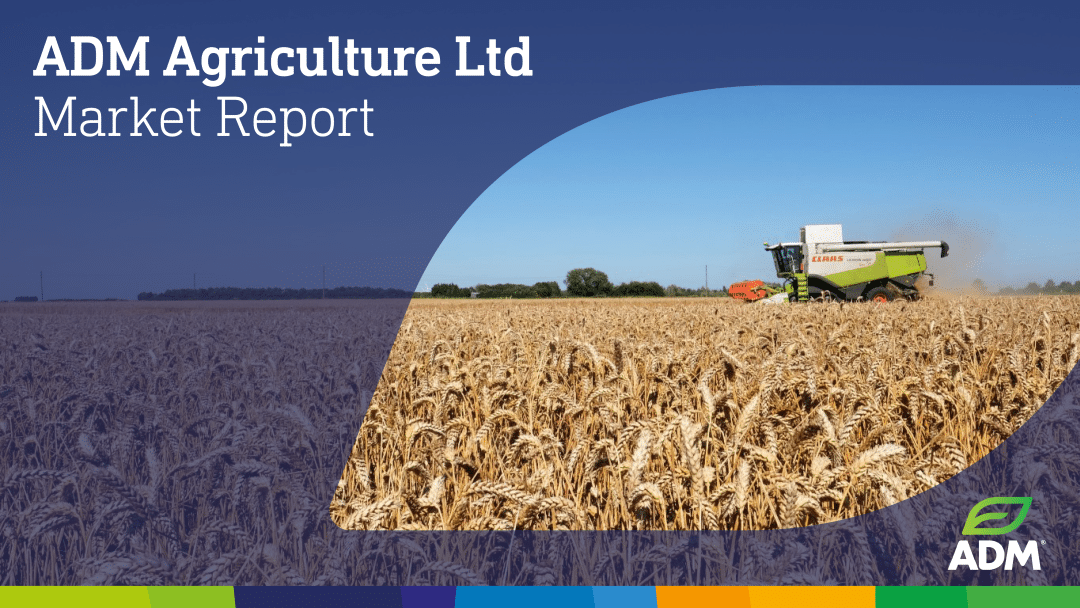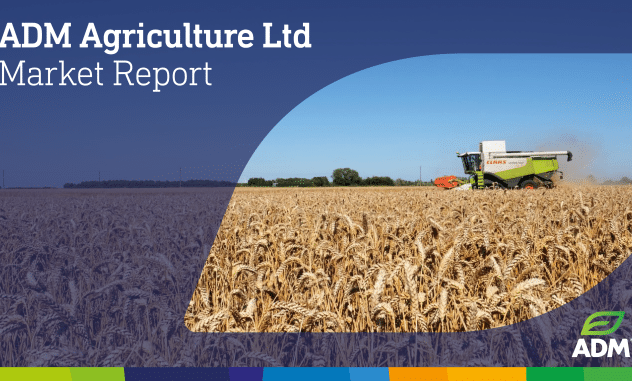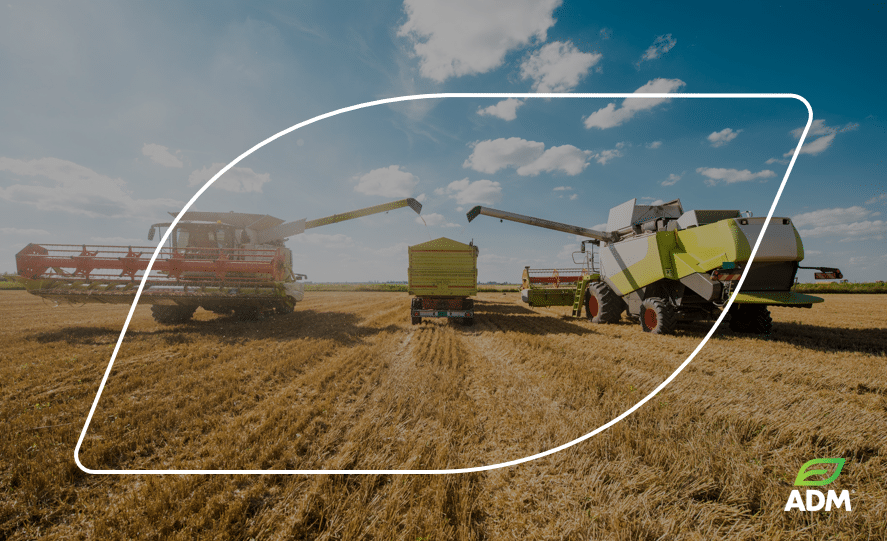WELCOME TO THE ADM AGRICULTURE WEEKLY MARKET REPORT
Wheat
- The US market has fallen $2.12/t w/w as bearish supply data weighs on values.
- US wheat yields were revised higher than expected in last week’s WASDE report. However, a downward revision in planted and harvested acreage resulted in a smaller crop being predicted. The US corn yield was also raised, but again acreage was cut due to preventive planting, and with increases in domestic usage, and exports, end-season stocks came in below expectations.
- European prices have fallen €5.00/t w/w as traders continue to assess the French crop. French farm office Agimer report, that while the wheat harvest is showing varied degrees of protein content, overall, the likely ‘average’ will be close to last year, but the picture looks far more variable in terms of specific weights.
- EU soft wheat exports had reached 3.1mln t a/o August 11th, down 22% y/y, although the line-up of French wheat exports is non-existent. The market focused heavily on last week’s announcement that Egypt was in the market to buy around 3.8mynt of wheat, which added a layer of support, but this did not materialise & was instead met with offers that did not attract, with only a total of 280,000t of Ukrainian and Bulgarian wheat purchased. Reports of higher freight costs over the extended delivery period, and payment terms were reasons put forward for the apparent ‘higher levels’ quoted, although traders also commented that Egypt was in private talks with suppliers on a direct wheat purchase plan.
- UK prices have also fallen w/w, trading £3.45/t lower. While harvest is progressing, it hasn’t yet reached the more northern and western parts of the country, and as transport logistics remain typically stretched for this time of year, spot premiums in these areas are still holding firm as merchants look to cover requirements, although in the more eastern regions, prices have come under pressure due to the increased available supplies.
- In summary, it was only a few boats to Cairo, not the 3.8mln t! WASDE did not do anything above what was expected on yields, but the decline in acreage took the shine off regarding final production. Europe still is fathoming out what it has, but concerns are now rising over the heatwave causing additional damage to not only Ukrainian corn harvest prospects but also to those in the eastern European states.
Barley
- The UK barley harvest has advanced by approximately 10% week on week, now 44% complete. Winter barley is all in the barn, and the spring barley is picking up steam now at 16% complete overall with the expectation of rapid progress over the next week under favourable conditions.
- The crop continues to come in in good quality and the trend of low moisture continues. Malting quality remains favourable albeit Nitrogen content is still lower than ideal, we are now starting to see quite a lot of broken grains in sample results, likely because of the very dry grains. We have not seen much response from the industry on this point just yet.
- Domestic feed barley demand has been strong over the last week, with futures pushing lower and barley maintaining favourable value within the feed matrix which is supporting inclusion rates. For another week however farmer selling is slow, once again growers seem unwilling to sell at today’s prices and remain focused on gathering in the harvest.
- Export demand is a different affair, and we see little to no interest from destination markets for further feed barley purchases. Even if demand was there, we are still seeing remnants of harvest pressure in the Black Sea, Germany, and Baltic origins which are undercutting UK replacement values. The UK market will need to calculate this demand at some stage in the season with a healthy surplus being harvested, however, we do not expect this to happen until farmers start to sell and provide the necessary liquidity.
- Malting barley markets continue their slide on thin demand, meanwhile, a growing surplus of malting quality barley is being harvested. For another week, export demand pays better than the domestic market although FOB buyers are now insisting on a minimum protein guarantee, something which at this stage the market is not willing to commit to until we have a better picture of overall quality. Overall, the tone of the market is unchanged on the week with weak markets showing no sign of support from demand. The question will be whether farmers are willing to risk selling malting barley as the premium continues to be eroded.
Rapeseed
- Ag markets have been mostly lower so far this week following a mixed USDA report on Friday. Overall, this was bearish soybeans and neutral to positive for grains. 24/25 yield was at 53.2 bushels/acre – a record high vs. expectations of 52.5 and last month’s fifty-two. This resulted in a larger production figure of 4.589 billion bushels vs. 4.472 expected and 4.435 in the last report. World ending stocks were sharply higher at 134.3 billion bushels up from 127.76 last report and 127.97 expected. We have seen some renewed buying interest from China, stepping in for multiple flash purchases which have helped support prices, showing that we are reaching a level that is cheap enough to attract the previously lacklustre demand.
- Energy markets have been mixed this week, falling back after reaching overhead resistance as we see EIA reduce the 2025 demand growth forecast from 980,000 barrels per day to 950,000 barrels per day due to the weaker Chinese economy. Prices have also dropped back with Middle East tensions less of a concern following Iran stating that renewed cease-fire talks could prevent retaliation. The weekly API report showed US crude stocks falling 5.2 million barrels vs. two million expected.
- Veg oils have been mostly lower as Malaysia’s Aug 1-10 palm exports fell 12.2%, though stocks are at a 4-month low. Also, USDA’s report kept its forecast for soy oil use in biofuel production unchanged with higher soybean production.
- Canola is lower this week, mainly following the soybean complex as a large soybean oversupply is leading the veg oil complex. Commercial stocks have reached a historical high of 2.02 mmt. Farmer deliveries to date as a percentage of production remain well below average levels. Exports for the marketing year 2023/24 were 19% lower than the previous year at 6.86 mmt which is the second lowest since 2007/08.
- MATIF rapeseed has also been mixed, trading within €452-€465 range being mainly influenced by outside markets as the Canola/Matif spread has now reached $80 meaning that any drop in canola prices must be met by the equal drop in Matif prices. Every major rapeseed producer in the EU with the exception of Lithuania has seen lower production figures this year compared to last, showing that there will be a gap in the S&D at some point in the year, however with nearby coverage good and an overwhelming amount of global soybeans it is yet to be seen when this will be.
Oats
- Oat markets in the EU remain at a bit of a crossroads with many in the industry now awaiting harvest results in Scandinavia before trading.
- Conditions in the Baltics have suffered from some recent heavy rain, and this is making sellers hesitant to offer quality grades.
- Demand for feed oats remains generally poor with very little trade being reported over the last few months. Consumers are seeing a glut of feed barley at cheap levels and therefore expect feed oat prices to fall in order to compete.
- Here in the UK, winter oat harvests are well on their way with reports of good quality and variable yields. Some spring oats that managed to be drilled on time have yielded exceptionally well with good quality and this has caused prices to fall. However, with the majority of the oat crop being made up of late drilled springs the market remains undecided on its direction. A poor yield and quality of these late springs will support prices, but if they are good then we could see the UK need to price for exports.
Pulses
- Another busier week for pulses this last week, with combines rolling throughout the southern half of the UK, as pulse crops offer a good alternative to dip into amongst weather stoppages on cereals. In terms of trade, there is some limited new crop interest circulating, however, both buyers and sellers alike seem keen to wait until they both have a better idea about the crop as harvest progresses. Human Consumption markets continue to be thin on the ground, more for a lack of sellers than anything else as the industry waits with bated breath to see what the quality is like.
- Beans have been cut across East Anglia and the Midlands, with samples already making their way into the lab. Early yields look promising, with many people reporting 3.5-4mt/ha. The week ahead looks like reasonable weather for the pulse harvest, with average temperatures across much of the UK, and only light rain across the midlands.
- Another week of muted new crop bean trade, again coming from the compound industry. Prices are coming under more pressure now, in part due to better-than-expected yields helping push prices lower, much as we have been saying over the last couple of months. Whilst there is a steadily growing interest in beans for the winter feed ration, prices are yet to become competitive vs the other competing protein feedstuffs, such as rapeseed meal and DDGs. The pricing spread has narrowed more aggressively over the last week, with new crop beans looking to be in the region of £15-20 too expensive on a relative basis. Our advice remains the same but is maybe a little more urgent as we see the prices continue to sink lower – speak to your farm trading representative about our range of marketing options, and see what markets are available. By selling to ADM, you can access one of the most advanced pulse processing plants in the UK and Europe, talk to your farm trader about some of our exciting upgrade opportunities, and the ability to potentially earn additional premiums and bonuses.
- Looking to the currency markets, GBPUSD is likely to remain volatile due to differing economic data between the UK and the US. However, there is the potential for USD strength if US inflation persists. GBPEUR looks to be a little more stable in the short term but watch for UK and Eurozone economic indicators. The European Central Bank’s policy stance will be crucial. Crudely, strong GBP = cheaper imports/weak GBP = more aggressive exports. Egypt will print its latest round of inflation data today, which could see further tightening of the Egyptian Monetary Policy, which could act to firm up EGP. This is still a flag to watch for any potential export markets, as the strength and liquidity of the EGP will drive Egypt’s buying power for new crop beans.
- We have already seen OSR being drilled, and whilst it may seem a lifetime away, it will soon be time to think about the CY25 drilling campaign. Peas and beans have a positive impact on soil health, with a comparatively light input burden compared to some other crops. Your farm trader will be able to talk you through some of the inputs that are great for pulse establishment, such as PGrow of FibroPhos, and advise on seed availability, and marketing options. With a wide spread of homes nationally, and the opportunity to upgrade human consumption pulses to be processed in one of the most advanced pulse processing plants in the UK and Europe, the team is here to help.
- The pea harvest is now well underway across much of the southern half of the UK at least, and the north is not that far behind. Early yields are mixed, although they broadly point towards better than expected, much as we have seen on the early beans. As we have said over the last couple of weeks, the European markets continue to support UK domestic and export demand on the back of variable yields, and the improved UK figures will help ease tensions in the global supply chain – however, strong yields domestically could well start to pressure prices lower here in the face of growing supply. We recently launched our buyback terms for 2025, which are still active, however are becoming very well-committed, so may not be around for too much longer.
- All offerings come with the option of numerous exclusive varieties to choose from. Please contact the pulse department or your local farm trader for our latest terms.
- Finally, the ever-present PGRO plug to those of you eligible to be members. If you are not already signed up to the PGRO mailing list, you can sign up here where levy payers can access all sorts of advice and support, tapping into their extensive knowledge bank on all things pulses for free! The PGRO is a unique organisation within the UK, and if you are paying for it, you may as well use it!!
Seed
- Looking for a herbal ley, legume fallow, or seed for another SFI scheme?
- At ADM we have a wide range of mixtures available to suit your requirements, we also offer bespoke mixes.
- Winter cover crops are a great option for grazing, whilst also improving soil conditions, using a range of components in your mix will often benefit your soils more.
- If you are drilling OSR this year, why not pair it with one of our companion crop mixtures, helping to aid the establishment of the OSR plant. Speak to your farm trader for more information and very competitive prices, we have various varieties of oilseed rape ready to despatch.
- Group1 wheats are getting short in the marketplace so if you are planning a crop, please talk to us along with any other seed requirements you may have to ensure you receive the best quality and service in the marketplace.
Fertiliser
- India announced its second urea tender of the year yesterday. We wait to see what will be offered and what India ends up bidding for to give us some indication of price direction going forward in the global urea market.
- International conflict in the Middle East and Russia/Ukraine is fuelling a rise across energy markets. A degree of nervousness is now creeping into the market.
- European gas traders have now stopped storing gas in Ukraine’s large gas stores which in past years have provided a tenth of the EU’s storage capacity. EU and UK natural gas futures are now at 8-month highs. Add in the cost of Ammonia, now $ 140 p/t more than it was in May, and a price increase in ammonium nitrate and urea will become a possibility heading into Q4.
- Indian importers continue to bid in a phosphate market in tight supply, facilitated by subsidies offered by the Indian government to importers.
- This global picture makes now feel a good time for UK farmers to cover their fertiliser needs across Ns, Ps, and Ks.
- It also makes the renewable P and K fertilisers supplied by UK power stations such as Fibrophos look more attractive, as their mined competition such as DAP and TSP see prolonged higher prices.
| £/€ | £/$ | €/$ |
|---|---|---|
| 1.1675 | 1.2855 | 1.1010 |
| Feed Barley £ | Wheat £ | Beans £ | Oilseed Rape £ | |
|---|---|---|---|---|
| Aug24 | 140-145 | 173-188 | POA | 375-385 |
NB: Prices quoted are indicative only at the time of going to press and subject to location and quality.
“Although ADM Agriculture take steps to ensure the validity of all information contained within the ADM Agriculture Market Report, it makes no warranty as to the accuracy or completeness of such information. ADM Agriculture will have no liability or responsibility for the information or any action or failure to act based upon such information.”
ADM Agriculture cannot accept liability arising from errors or omissions in this publication.
ADM Agriculture trade under AIC contracts which incorporate the arbitration clause.
Terms and Conditions of Purchase.
On every occasion, without exception, grain and pulses will be bought by incorporating by reference the terms & conditions of the AIC No.1 Grain and Peas or Beans contract applicable on the date of the transaction. Also, we will always, and without exception, buy oilseed rape and linseed by incorporating by reference the terms & conditions of the respective terms of the FOSFA 26A and the FOSFA 9A contracts applicable on the date of the transaction. It is a condition of all such transactions that the seller is deemed to know, accept and understand the terms and conditions of each of the above contracts.



